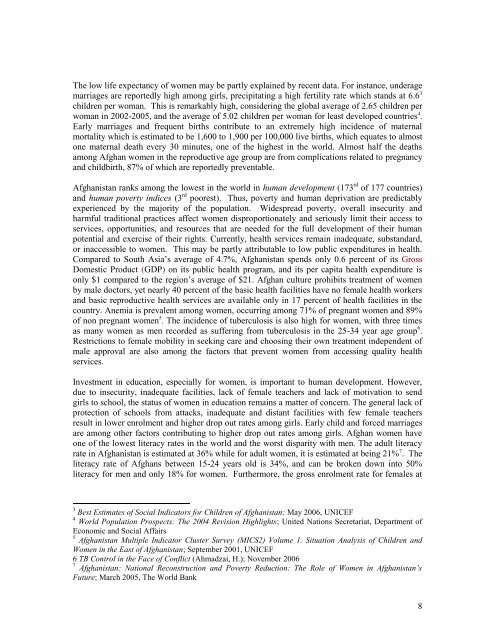National Action Plan for the Women of Afghanistan - The Secretary ...
National Action Plan for the Women of Afghanistan - The Secretary ...
National Action Plan for the Women of Afghanistan - The Secretary ...
- No tags were found...
Create successful ePaper yourself
Turn your PDF publications into a flip-book with our unique Google optimized e-Paper software.
<strong>The</strong> low life expectancy <strong>of</strong> women may be partly explained by recent data. For instance, underage<br />
marriages are reportedly high among girls, precipitating a high fertility rate which stands at 6.6 3<br />
children per woman. This is remarkably high, considering <strong>the</strong> global average <strong>of</strong> 2.65 children per<br />
woman in 2002-2005, and <strong>the</strong> average <strong>of</strong> 5.02 children per woman <strong>for</strong> least developed countries 4 .<br />
Early marriages and frequent births contribute to an extremely high incidence <strong>of</strong> maternal<br />
mortality which is estimated to be 1,600 to 1,900 per 100,000 live births, which equates to almost<br />
one maternal death every 30 minutes, one <strong>of</strong> <strong>the</strong> highest in <strong>the</strong> world. Almost half <strong>the</strong> deaths<br />
among Afghan women in <strong>the</strong> reproductive age group are from complications related to pregnancy<br />
and childbirth, 87% <strong>of</strong> which are reportedly preventable.<br />
<strong>Afghanistan</strong> ranks among <strong>the</strong> lowest in <strong>the</strong> world in human development (173 rd <strong>of</strong> 177 countries)<br />
and human poverty indices (3 rd poorest). Thus, poverty and human deprivation are predictably<br />
experienced by <strong>the</strong> majority <strong>of</strong> <strong>the</strong> population. Widespread poverty, overall insecurity and<br />
harmful traditional practices affect women disproportionately and seriously limit <strong>the</strong>ir access to<br />
services, opportunities, and resources that are needed <strong>for</strong> <strong>the</strong> full development <strong>of</strong> <strong>the</strong>ir human<br />
potential and exercise <strong>of</strong> <strong>the</strong>ir rights. Currently, health services remain inadequate, substandard,<br />
or inaccessible to women. This may be partly attributable to low public expenditures in health.<br />
Compared to South Asia‘s average <strong>of</strong> 4.7%, <strong>Afghanistan</strong> spends only 0.6 percent <strong>of</strong> its Gross<br />
Domestic Product (GDP) on its public health program, and its per capita health expenditure is<br />
only $1 compared to <strong>the</strong> region‘s average <strong>of</strong> $21. Afghan culture prohibits treatment <strong>of</strong> women<br />
by male doctors, yet nearly 40 percent <strong>of</strong> <strong>the</strong> basic health facilities have no female health workers<br />
and basic reproductive health services are available only in 17 percent <strong>of</strong> health facilities in <strong>the</strong><br />
country. Anemia is prevalent among women, occurring among 71% <strong>of</strong> pregnant women and 89%<br />
<strong>of</strong> non pregnant women 5 . <strong>The</strong> incidence <strong>of</strong> tuberculosis is also high <strong>for</strong> women, with three times<br />
as many women as men recorded as suffering from tuberculosis in <strong>the</strong> 25-34 year age group 6 .<br />
Restrictions to female mobility in seeking care and choosing <strong>the</strong>ir own treatment independent <strong>of</strong><br />
male approval are also among <strong>the</strong> factors that prevent women from accessing quality health<br />
services.<br />
Investment in education, especially <strong>for</strong> women, is important to human development. However,<br />
due to insecurity, inadequate facilities, lack <strong>of</strong> female teachers and lack <strong>of</strong> motivation to send<br />
girls to school, <strong>the</strong> status <strong>of</strong> women in education remains a matter <strong>of</strong> concern. <strong>The</strong> general lack <strong>of</strong><br />
protection <strong>of</strong> schools from attacks, inadequate and distant facilities with few female teachers<br />
result in lower enrolment and higher drop out rates among girls. Early child and <strong>for</strong>ced marriages<br />
are among o<strong>the</strong>r factors contributing to higher drop out rates among girls. Afghan women have<br />
one <strong>of</strong> <strong>the</strong> lowest literacy rates in <strong>the</strong> world and <strong>the</strong> worst disparity with men. <strong>The</strong> adult literacy<br />
rate in <strong>Afghanistan</strong> is estimated at 36% while <strong>for</strong> adult women, it is estimated at being 21% 7 . <strong>The</strong><br />
literacy rate <strong>of</strong> Afghans between 15-24 years old is 34%, and can be broken down into 50%<br />
literacy <strong>for</strong> men and only 18% <strong>for</strong> women. Fur<strong>the</strong>rmore, <strong>the</strong> gross enrolment rate <strong>for</strong> females at<br />
3 Best Estimates <strong>of</strong> Social Indicators <strong>for</strong> Children <strong>of</strong> <strong>Afghanistan</strong>; May 2006, UNICEF<br />
4 World Population Prospects: <strong>The</strong> 2004 Revision Highlights; United Nations Secretariat, Department <strong>of</strong><br />
Economic and Social Affairs<br />
5 <strong>Afghanistan</strong> Multiple Indicator Cluster Survey (MICS2) Volume 1. Situation Analysis <strong>of</strong> Children and<br />
<strong>Women</strong> in <strong>the</strong> East <strong>of</strong> <strong>Afghanistan</strong>; September 2001, UNICEF<br />
6 TB Control in <strong>the</strong> Face <strong>of</strong> Conflict (Ahmadzai, H.); November 2006<br />
7 <strong>Afghanistan</strong>: <strong>National</strong> Reconstruction and Poverty Reduction: <strong>The</strong> Role <strong>of</strong> <strong>Women</strong> in <strong>Afghanistan</strong>’s<br />
Future; March 2005, <strong>The</strong> World Bank<br />
8
















